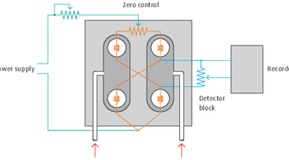A universal detector and can detect air, hydrogen, carbon monoxide, nitrogen, sulfur oxide, inorganic gases and many other compounds.
Thermal conductivity detector (TCD)

Thermal conductivity (TCD) is a commonly used detector in gas chromatography. TCD works by having two parallel tubes both containing gas and heating coils.
The gases are examined by comparing the heat loss rate from the heating coils into the gas. Normally one tube holds a reference gas and the sample to be tested is passed through the other.
Using this principle, a TCD senses the changes in the thermal conductivity of the column effluent and compares it to a reference flow of carrier gas. Most compounds have a thermal conductivity much less than that of the common carrier gases of hydrogen or helium.
Therefore, when an analyte elutes from the column, the thermal conductivity of the effluent is reduced and a detectable signal is produced.
Helium has traditionally been the favoured carrier gas but as laboratory trends change.